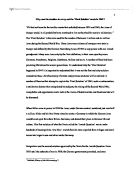After the extinction of the Qing dynasty, the new system under the KMT regime resulted in low availability for education due to its unaffordable fees in spite of banishing most Confucianism. Thus, education became a pillar of social reform across China as “New educational models from European, American and Japanese were set up in China.”(CEC, 2017) This system was good from the students’ and China’s perspective since it gave students a broader view of the world ultimately benefited China to catch up with modern society. Nonetheless, most families found it impossible to pay for schools fees which made education scarce and only affordable to the wealthy “the tuition fees for elementary school, much less middle or higher education, were within reach of the wealthiest minority in China.” (Nedostup, R., 2001). Furthermore, the majority of graduates were unwilling to work commonly known as “attitude of entitlement” (Hong, 2001). Accordingly, this system shows that the public was not capable of affording education hence showed regression regarding availability.
Mao’s policies and political movement overturned traditional norms, yet he used unqualified teachers and guiding ideologies as propaganda tools which excessively affected the student’s education. Likewise, Well-educated and wealthy individuals became targets, and Mao considered schools as one of his channel of propaganda. Shown in Da Chen’s novel China’s son, he wrote “Mr Sun was bidding us a sad goodbye. He was heading to a re-education camp for teachers …... a directive from the central government that from now on all schools would be governed by poor farmers”(Chen, 2001, p. 15). This policy indicated that the Communist Party sent qualified teachers to the re-education camp and the teaching quality had regressed. Instead, uneducated farmers replaced teachers for teaching which hugely affects the student's education, and yet farmers were completely unqualified to teach, hence, incapable of delivering knowledge to students. Moreover, the communist party disallowed Da to attend junior high because his father and grandpa went to college. On the contrary, the worse students from his primary school went on to junior high (Chen, 2001, p.79). This decision clearly showed that Mao judged more on student's family background than grades. Similarly, the curriculum in the Mao era was radically different regarding delivery. In conclusion, these policies were propaganda tools used to deliver Maoism included banishing children from particular family background to attend school besides that; Mao had prohibited all students from receiving proper education from qualified teachers in school, eventually regressed regarding ideologies and availability.
Finally, in the post-Mao era, as Deng Xiaoping spearheaded China’s reform and opening-up policy, the education system reverted to accepting Western concepts. For instance, “Chinese education system was deemed to be a major factor in the advancement of economic and modernization. Science and technology became an important focus of education policy” (Tao, 2014). This policy showed that Deng promoted new reform policies to reintroduce Western concepts. As a result, state-run schools experienced dramatic improvements and provided a primary education across China. Correspondingly, Deng removed the propaganda element that existed in Mao's curriculum, meaning Deng’s system judged more on student's merit than family lineage as in the past which motivated economic progression and innovation rather than filling senior official positions. Therefore, the education system at all levels became much more competitive. Overall, The post-Mao period was arguably the most important regarding reforming the Chinese education system because the availabilities of schooling and curriculum content made a stark improvement. In addition, the number of engineers produced reflected that this education reform played a fundamental role in providing qualified human capital. Today America produces only 60,000 to 70,000 engineers per year while China produces over 400,000 engineers per year(Carson, 2004).
In conclusion, China’s education system made stupendous progress on public availability and ideologies from 1900-1997 despite temporary regression. Due to the unstable political and economic situation happened in China, which created a tremendous amount of restriction on knowledge and availability of schooling for students, this had a huge effect on student’s progress. Thence, the way that individuals comprehend and react to changes rely upon their background and viewpoint, which indicates different people respond differently to changes.
References
Andreas, J. (2009). Rise of the red engineers the Cultural Revolution and the origins of China's new class. Stanford, CA: Stanford University Press.
Chen, D. (2001). China's son: Growing up in the Cultural Revolution. New York: Dell Laurel-Leaf.
China's communist revolutions: Fifty years of the people's republic of china. (2015). Place of publication not identified: Routledge.
Lu, X. (2004). Rhetoric of the Chinese Cultural Revolution: The impact on Chinese thought, culture, and communication. Columbia, S.C: University of South Carolina Press.
Myers, J. T. (1986). Chinese politics: Documents and analysis. Columbia, S.C: University of South Carolina Press.
Peterson, G. (1997). The power of words: Literacy and revolution in South China, 1949-95. Vancouver: University of British Columbia Press.
President Chiang Kai-shek's selected speeches and messages. (n.d.). Taipei, Taiwan: China Cultural Service.
Nedostup, R., & Hong-Ming, L. (2001). “Begging the Sages of the Party-State”: Citizenship and Government in Transition in Nationalist China, 1927– 1937. International Review of Social History, 46(S9), 189.
Tao, Liqing, Margaret Berci, and Wayne He. "Historical Background: Expansion of Public Education." The New York Times. The New York Times, n.d. Web. 17 Apr. 2014. <http://www.nytimes.com/ref/college/coll-china-education-001.html#republic>
America the Beautiful Quotes by Ben Carson. (n.d.). Retrieved April 14, 2017, from https://www.goodreads.com/work/quotes/18338874-america-the-beautiful-rediscovering-what-made-this-nation-great








